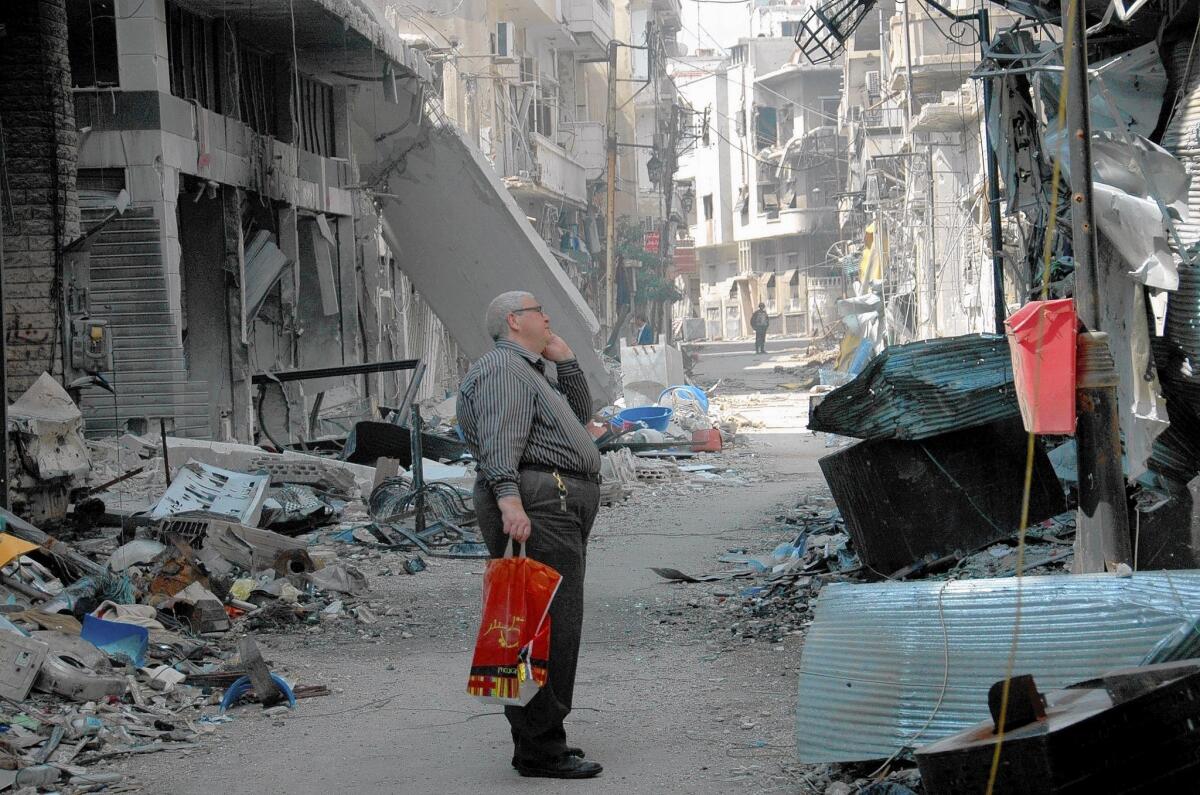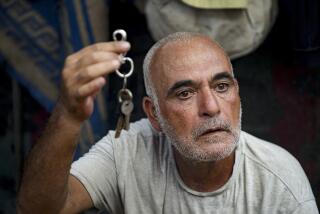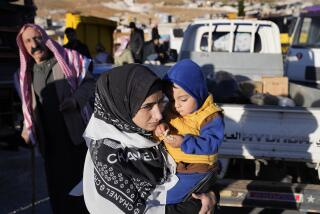In Syria, Homs residents salvage belongings after rebels leave

The people of war-battered central Homs came Sunday to salvage what remained of their belongings and residences after years of conflict and siege.
Most found little beyond devastated homes, looted businesses and a handful of tokens from better times. They grabbed what they could, stuffing what remained of their former lives into baby strollers, suitcases, or plastic bags and onto bicycles and scooters to take to their new homes, typically temporary residences, often with relatives or in shelters.
“It’s not much, just a few small things,” said Rafi Sepechian, as he and his wife lugged several chairs, a floral print and a suitcase full of odds and ends from their former flat in the Old City. “It’s badly damaged, but we plan to rebuild. We love our home.”
The once-bustling heart of Syria’s third-largest city is now a jumble of bombed-out buildings, bullet-sprayed storefronts and rubble-strewn streets and alleys. Shelling, aerial bombardment and gun battles have taken an extraordinary toll. Sidewalks are piled high with chunks of masonry, sections of rebar, sundry kinds of trash and other detritus, such as mattresses, computer parts and electrical wires. The smell of smoke is pungent.
A deal finalized last week led to the evacuation of about 2,000 rebel fighters from the historic Old City, allowing residents and shop owners to return for the first time since 2012.
But the Old City and other adjacent former opposition strongholds remain largely uninhabitable. Apart from the damage, there is no running water or electricity. The traffic of former residents collecting their meager belongings clogged the battered streets.
Retaking control of central Homs is a major victory for the Syrian government, which is seeking to project an image of growing stability ahead of the presidential election scheduled for June 3.
Home to more than 2 million people before the war broke out in 2011, Homs has both strategic and symbolic significance. When the uprising began, the city was widely dubbed “the capital of the revolution” against the government of President Bashar Assad. Homs is situated in the heart of Syria, along the routes of major highways south to Damascus, north to Aleppo and west to the Mediterranean coast, a government stronghold.
On Sunday, an almost festive air prevailed here, despite a sense of gloom at the utter scale of the destruction. War-weary residents seemed keen to show their resolve. Many voiced hope that the more than three-year conflict could be winding down, though fighting continues in many parts of Syria, including another rebel-held neighborhood of Homs, Waer, where more than 200,000 people live.
“I think everyone has had enough,” said a bus driver known by the nickname Abu Zacarias, who said his home had been destroyed and who was pushing a bicycle that carried blankets and other items from his sister’s residence. “We want things to go back [to] where they were before.”
Not everyone in this deeply divided city is happy to see the Syrian army back in control. But few are willing to talk about such matters openly, especially to foreign journalists. One 21-year-old student, who like many others declined to give his name for security reasons, did approach a reporter to express his misgivings.
“I wish I could take out my green flag,” said the young man, referring to the Syrian rebel banner.
There were no regrets from soldiers such as Abu Jaffa, 25, who said he had been wounded on six occasions by shrapnel and bullets. “I would endure much more to win this battle,” said the soldier, who, like several others, preferred to be identified by a nickname.
With the central city now largely under government control, many residents said they thought that car bombings and mortar strikes emanating from rebel-held zones may cease. In recent weeks, the city has suffered a paroxysm of violence, with bombings leaving scores dead.
Christians, who formed a significant part of the Old City population, held a celebratory Mass at the Our Lady of the Belt Syriac Orthodox Church, which was badly damaged but remains standing. The church is known for a venerated relic said to be part of a belt associated with Mary, the mother of Jesus.
At the start of the fighting, clerics removed the relic, precious icons and other valuable items for safekeeping. Looters later dug up the spot below the altar where the relic was kept, priests said, but the item had been safely spirited away by church officials.
“I know there is damage, but this is the happiest moment in my life, to be back in the church where I was baptized and my son was baptized,” said Sawsan Hanoon, 40, standing in the debris-filled patio of the church. “We will rebuild it with our own hands.”
A few blocks away, mourners came to pay respects at the grave of Father Frans van der Lugt, a 76-year-old Dutch Jesuit assassinated by an unknown masked gunman last month on the grounds of the Jesuit residence. He had refused to leave the district where he had lived for decades even after the rebels took control.
The Jesuit was often seen on his bicycle bringing food, medicines and other aid to the needy in the besieged district. Friends said he disregarded the constant danger in his bid to help residents regardless of their creed. He is buried beneath a tree in the garden of the Old City residence. For many, Sunday was the first opportunity to visit his grave.
The spot where he was shot dead, a few yards away, was marked by a simple plastic chair adorned with plastic flowers.
“We all learned so much from Father Frans,” said Mazen Kounnuwaty, 50, an engineer who remained in the Old City until February, losing more than 70 pounds because of the scarcity of food. “He never threatened anyone, only helped people of all sects. Why he was killed we still don’t understand.”
In the adjacent Khaldiya district, where fighting has destroyed much of what was once a vibrant residential neighborhood, residents were also able for the first time to gain access to their homes and to the area’s major landmark — the majestic mosque of Khalid ibn al-Walid. The soaring structure features a pair of minarets and silver domes that once dominated the vista. The mosque’s namesake, a companion of the Muslim prophet Muhammad, is considered by many residents as a guardian of Homs.
During the conflict, artillery shells struck several domes of the mosque, leaving gaping holes open to the sky. Inside, bullets have gouged out chunks of the walls and there is fire damage. But the mosque’s essential structure remains intact.
“It’s very confusing and troubling to see this,” said Samar, 25, who is studying to be a teacher. “We in Homs are fed up with war. I wish we could all shake hands and go back to where we were before. But it’s not so easy.”
As dusk approached, the thud of mortars and the crackle of distant gunfire echoed across the battle-scarred city. Residents accustomed to the sounds of war hardly took notice.
More to Read
Sign up for Essential California
The most important California stories and recommendations in your inbox every morning.
You may occasionally receive promotional content from the Los Angeles Times.









